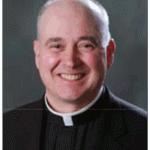(Pastor’s Note from the Mary Immaculate of Lourdes Parish Bulletin for August 19, 2012)
On Wednesday of this past week, August 15th, we celebrated the feast-day of the Assumption of the Blessed Virgin Mary into Heaven, body and soul. Although belief in the Assumption of Mary had long been held in the Church, it was not until relatively recently that a Pope solemnly defined it with the certainty of faith. This Solemn Definition took place on November 1st, 1950, in Rome when Pope Pius XII publicly proclaimed: “After frequently praying to God and invoking the light of the Spirit of truth, to the glory of Almighty God who enriched the Virgin Mary with special favor to the honor of her Son, the immortal
King of ages and victor over death and sin, to the increase of the glory of His august Mother, to the joy and exultation of the whole Church, by the authority of our Lord Jesus Christ and of the holy Apostles Peter and Paul and by Our own authority, We declare and define as a revealed dogma that the Immaculate Mary ever-Virgin, Mother of God, when she had finished the course of her earthly life, was taken up body and soul into the glory of heaven.”
The question may arise: well, if the Assumption of Mary was already believed in and observed as a liturgical feast-day, what exactly did the Solemn Definition of 1950 change? The answer is: what changed was the theological grade of certainty. The Assumption of Mary went from being a probable opinion, which it would have been “impious and blasphemous to deny” (Pope Benedict XIV), to a defined dogma of the Catholic Faith.
The Solemn Definition of the Assumption of Mary was an instance of the Infallible Teaching Office of the Church, the “Magisterium”, exercising its authority to vouch for the fact that a Truth is contained in God’s Divine Revelation. When we give our free assent to it we reinforce our act of faith in the Catholic Church as a divine institution.
Not all the Catholic Truths are proposed for our belief with the same degree of theological certainty. The highest degree or grade of theological certainty is accorded to those Truths which are “of FAITH”—de fide. If its certainty is based on God’s Revelation it is “divine faith”: if its certainty is based on the Magisterium’s teaching that the Truth is part of Revelation it is “Catholic faith”. Hence, the expression “of divine and Catholic faith”. Moreover if the Truth is defined by a solemn judgment of the Pope or of a General Council it is said to be of “defined faith”. The Assumption of Mary into Heaven is just such a Truth. We believe in it de fide.
Other grades of theological certainty include doctrines which the Magisterium of the Church has decided are to be accepted with a faith solely based on the authority of the Church—ecclesiastical faith. The infallibility of the Church includes these doctrines as well as dogmas proper.
Then there are those doctrines considered as “Teachings proximate to the Faith”, regarded by theologians generally as truths of Revelation but not finally presented by the Church as such, or “Teachings pertaining to the Faith”, which again the Church has not pronounced on but their truth is guaranteed by their intrinsic connection with the doctrine of Revelation.
“Common Teaching” (sententia communis) is a doctrine which although in itself still in the field of free theological opinion is generally accepted by theologians as true. An example would be the belief that Mary underwent a bodily death (her “Dormition”) prior to her Assumption.
Other theological opinions of lesser grades of certainty are listed as “Probable”, “More Probable”, and “Well-founded”. Those opinions which are in agreement with the consciousness of Catholic faith are categorized as “Pious Opinions” (sententia pia). The phrase used for that is: “it may be piously believed…” An example of this was Pope John XXIII’s favorable endorsement of the bodily assumption of St. Joseph into Heaven as a pious belief.
The least degree of certainty is the Tolerated Opinion (opinio tolerata), which is only weakly founded but nonetheless tolerated by the Church.
It ought to be clear then that the Church’s Teaching Authority takes great care to distinguish between its grades of certainty so
that only the most important things, expressed in terse, precise formulas, are to be believed as de fide. Catholic Truths are anything but a “Party line” or a stultifying list of fundamentalist, time-bound thought-controls. The Living Magisterium of the Church allows plenty of room for the Holy Spirit to maneuver, while at the same time safeguarding against mistaking the “spirit of the age” for the promptings of the Holy Spirit of God.
(Source: Fundamentals of Catholicism, Dr. Ludwig Ott, Introduction, “Theological Grades of Certainty”, 4th edition, A.D. 1960)
